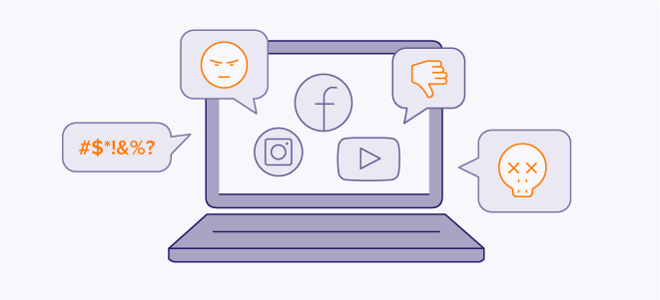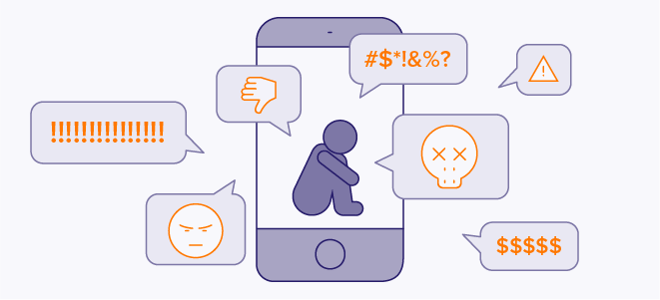What is cyberbullying, exactly?
Cyberbullying is the act of intimidating, threatening, or coercing people online through the use of social media, email, text messages, blog posts, or other digital or electronic methods. Also called digital harassment, cyberbullying usually involves the use of derogatory, aggressive, or threatening language. To mask their real identity, cyberbullies often hide behind fake digital personas.
Cyberbullying often involves sending the victim threatening messages, posting compromising photos or videos of the victim on social media sites, or even creating a fake website about the victim. While bullying is not new, cyberbullying takes harassment to a frightening new level. As has often been documented in the news, the effects of cyberbullying can be devastating and even fatal.
According to the Cyberbullying Research Center, about 34% of middle school and high school students have experienced online harassment. Several research studies have shown that cyberbullying is linked to low self-esteem, anger, frustration, and suicidal thoughts. Given the gravity of the issue, it’s important for both parents and kids to understand what to do about cyberbullying and the many forms it can take.
Common examples of cyberbullying
Unfortunately, there are many different types of cyberbullying. Here are a few common examples.
Harassment
Just like the offline variety, cyber harassment encompasses a range of threatening behavior. It especially refers to repeatedly sending insulting or demeaning messages. Cyberstalking is another form of online harassment. Mob harassment occurs when an entire group collectively cyberbullies one individual.
Sexual Harassment
Sexual harassment also happens in cyberspace and can include messages with sexual content as well as the posting of compromising photos or video. Revenge porn is the posting or distributing of sexual content without consent, in an attempt to get revenge on someone such as a former partner.
Trolling
The term trolling actually comes from fishing, not from disgruntled creatures living under bridges. The fishing term describes the technique of slowly dragging bait from a boat in order to lure in fish. Similarly, internet trolling involves dangling “bait” (in the form of lies or inside jokes) to goad someone into an emotional reaction.
Outing/Doxing
Outing, or doxing, refers to sharing someone’s personal information online without their consent. For example, a cyberbully might share a private text or email with the outside world in order to embarrass or humiliate. Doxing can also refer to publishing someone’s private contact info, like their address, online.
Fraping
Fraping means breaking into someone’s social media accounts (or even creating a fake profile under their name) to impersonate them. The bully will often attempt to humiliate the person or ruin their reputation by posting inappropriate, derogatory, or inflammatory comments.
Dissing
When a cyberbully spreads rumors or posts humiliating photos, videos, or screenshots of their victim, that’s referred to as dissing. Generally, the bully seeks to embarrass, shame, and ruin reputations and friendships.
Catfishing
Catfishing refers to creating a fictitious persona and then luring a victim into an online relationship, usually romantic. Catfishers targeting adults usually ask for money, and they’re quite successful with the scam: the FBI reported that romantic scams cost Americans $363 million in 2018 alone. Catfishers targeting teens may be after personal information instead, and can use it for dissing or fraping.
Swatting
Swatting is a newer form of cyberbullying in which a bully makes a phony call to emergency services, describing a hostage situation, bomb threat, or other critical condition. Police then rush in (sometimes with a SWAT team, hence the name), and things can escalate drastically from there. An Ohio teen was recently sentenced to prison after he hired someone to make a swatting call that resulted in police shooting and killing an innocent man.
Exclusion
Just like real-life exclusion, bullies use this tactic to show their victims that they’ve been rejected from a social circle. Bullies may accomplish this without directly messaging their victim, but rather posting pictures on social media that show the whole group (without the victim) spending time together.
Cyberbullying on social media
Cyberbullying can happen anywhere online, but it’s particularly likely to occur on social media platforms, like Facebook, Instagram, Twitter, Snapchat, and TikTok. It also occurs through games with voice or text chatting, such as Overwatch, League of Legends, and Fortnite, as well as through video-sharing sites like YouTube.
Social media, games, and video streaming are immensely popular with teens, and banning them is not a realistic solution. So what can be done about cyberbullying on social media? See below for tips on how to prevent it or what to do if it’s already happening.

Why do people cyberbully?
Cyberbullying comes from the same dark and demented place as real-world bullying: the desire to exert power and elevate the bully’s social status by belittling and humiliating others, especially if the bully thinks the other person is weaker or somehow threatening.
Cyberbullies may post anonymously, hide behind online identities, or even use their real identities in the knowledge that they won’t be physically confronted by their victim. Many cyberbullies will say or post things online that they would never have the courage to say in real life.
When did cyberbullying start? Unfortunately, the history of cyberbullying is about as old as the widespread use of affordable PCs.
Is cyberbullying a crime?
While there is currently no federal law in the US that explicitly prevents cyberbullying by name, all states outlaw bullying, and most include a reference to the online variety as well. Additionally, many forms of cyberbullying fall under other illegal categories, such as harrassment (especially if it has a basis in gender or race), threats, stalking, extortion, undeage sexting or sexual extortion, or cybercrime.
If you’re wondering about a specific instance of cyberbullying that affects you or your child, speak to a guidance counselor, or other trusted staff member, at your local school. Many districts have rules and procedures in place to address cyberbullying. You can also check out StopBullying.gov to see the local laws in your area.
How to recognize cyberbullying
As mentioned above, any hurtful, demeaning, or threatening message sent over an electronic medium is cyberbullying. It also includes humiliating photos or videos posted on public sites, such as Facebook or YouTube, without consent. Fake profiles or websites that aim at exposing or invading privacy can also be considered cyberbullying.
Often, the most difficult part of combating cyberbullying can be convincing ashamed and/or frightened victims to admit they’re being targeted. If you’re a parent wondering about your child or teen, look for warning signs. In general, be wary of out-of-character behavior with digital devices, such as:
-
Suddenly no longer using their devices, or using them much more than normal
-
Seeming upset, angry, or down after using social media or gaming
-
Reclusive behavior, including trying to avoid school or social events
-
Avoiding discussing their social life, both online and off
-
Negative mood swings, problems in school, depression
Cyberbullying doesn’t target only kids. And there are some strategies that adults, teens, and kids can use against cyberbullying.

How to prevent cyberbullying
Unfortunately, as long as there are mean-spirited people, it seems unlikely we’ll ever be able to stop cyberbullying completely. It can also be difficult to stop the vitriol cyberbullies create — the posts, websites, or videos that attack the target — as it can require a lengthy, difficult process to get platform admins to delete that content. And by that point, copies have often been made and distributed, which means it’s nearly impossible to delete the content for good.
However, you can take several actions to prevent cyberbullying and even stop it in its tracks.
 Block harmful or hateful accounts
Block harmful or hateful accounts
One way to handle cyberbullying is to unfriend and block the bully. Whether it’s Facebook, Instagram, or an online game, there should always be an option to block another user. This prevents the bully from messaging you, posting on your profile, tagging you in posts, or contacting you in any way. The process to do this varies a bit from platform to platform, but you can refer to our guide for how to block users on Facebook as one example.
 Make your social media accounts private
Make your social media accounts private
If a bully can’t find your account, they’ll have a much harder time getting to you. You should only connect on social media with people you trust. Additionally, it’s better from a data-privacy standpoint to have your accounts locked down. Here’s how to tighten up your privacy settings on Facebook and secure your Instagram account.
 Don’t send photos or videos
Don’t send photos or videos
You should avoid sending any photos or videos of yourself, your home, or anything private to people you meet online. These images could be used against you or to find more information about you. This is especially true about explicit photos or videos, which you should never send to anyone. Even spouses should not send these types of pictures to each other, as hackers could steal them from your drive and use them for harassment or blackmail.
 Report the bullies
Report the bullies
All online platforms should have the option to report inappropriate or derogatory content. Moderators should be able to remove the content and even block repeat offenders from using the platform. Here’s how to report abusive content on Facebook, and it should be fairly similar on Instagram, Twitter, Youtube, and other platforms.
Protect your passwords
Another way to prevent cyberbullying is to protect your devices and passwords. You should set a password on your phone, tablet, and computer so that no one can break in and use your devices without your consent.
You should also make sure to have strong, unique passwords for each of your online accounts. Weak passwords could allow cyberbullies to break in and use your accounts for fraping, dissing, or other forms of harassment.
If it seems difficult to remember complicated passwords for each separate account, consider using a password manager.
Protect your devices with cybersecurity software
The line between cyberbullying and hacking can be thin. If your devices are ever threatened or a bully tries to spear-phish you to steal your data, strong antivirus software will ensure that your personal information isn’t compromised.
Protect your online privacy and security with Avast One
If cyberbullies can't get any information on you, they won’t have any ammunition. That’s why it’s so important to secure your devices against all kinds of online threats. Avast One is a comprehensive security and privacy suite with built-in data-leak monitoring and a VPN to keep all your communications private.
Download Avast One and make sure that any hackers or cyberbullies who try to spy on you or steal your data are completely blocked.

